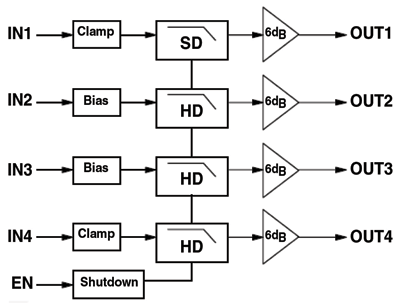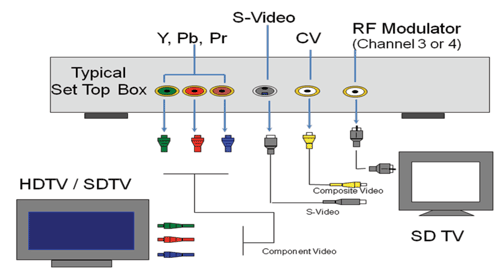IC manufacturers are adapting to these trends and providing equipment makers with a range of product options
BY BILL BOLDT, Sr. Business
Development Manager
Signal Path Products
Fairchild Semiconductor
www.fairchildsemi.com
Four major trends describe today’s video filter driver market: 1) higher definition, 2) mobile video, 3) green requirements, and 4) a re-think of video output schemes. These trends are having an impact on the video output circuit configurations of set top boxes, DVD and BluRay players/recorders, televisions, Personal Media Players, cameras, and cell phones. With advances in digital video, an increasing number of video signals are now being routed using HDMI technology, but because of the notion of backwards compatibility, analog video signals still represent the lions’ share of inter-equipment video signaling. Therefore, supporting analog signals remains a significant concern for video equipment makers. Integrated circuit (IC) manufacturers are adapting to these key video market trends and providing video equipment makers with a range of product options. Since video filter driver ICs span a wide range of video platforms they serve as a good example to demonstrate market tracking, so that is where we will focus.

Fig. 1: Video filters support market trends.
![]()
The list of trends in Figure 1 is self-explanatory, with the possible exception of the 4-channel configuration. So, what market trend does the four-channel configuration track? It tracks the growing penchant for elimination of the two SD (standard definition) channels that were traditionally used for S-video, which is a two-channel output scheme originally meant as an improvement over single channel composite video (CVBS).
Four channels
Over time, S-video became somewhat redundant since three-channel component video performs better than S-video (because three signals naturally carry more information than two). The advent of DVD drove adoption of three-channel component video because DVD benefited from the picture improvement afforded by three channels. In practice, S-video effectively fell through the cracks between CVBS and component video. As a result, its practical use has tapered off and S-video is starting to flirt with obsolescence. Recognizing this, certain set top box system manufacturers have started to eliminate S-video support on some models to save the cost of the extra connectors and circuitry. In response to this trend, Fairchild offers the FMS6144A four-channel SD video filter for the CVBS (one-channel SD) plus component (three-channel SD) video set up.
One lucky break for video equipment designers was that three-channel component video was perfectly suited to support HD 720p/1080i (referred to here as HD), so when that showed up on the scene component video outputs could be easily reconfigured for 720p/1080i bandwidths. That meant filtering consisting of three HD channels (30-MHz filters) to support Y, Pb, Pr signals was needed. Fairchild addresses the HD requirement with several products, with the most prominent being the FMS6363A (three-channel HD) and FMS6346E (three-channel HD + three-channel SD). If we look at the intersection of the trend of elimination of S-video with the trend of HD, we will see that a new four-channel configuration: three HD channels for component video plus one SD channel for CVBS is ideal. The FMS6364E (Figure 2 ) specifically addresses that market intersection.

Fig. 2: FMS6364E supports three HD and one SD channel.

Fig.3: Typical STB 6-output configuration.
However, not all system manufacturers have been so quick to eliminate S-video and full six-channel output support is still required, especially for higher end models. The six channels are easy to see in Figure 3 , which shows one channel for CVBS (yellow), three channels for component (Y-the green jack, Pb-the red jack, and Pr-the blue jack) and two for S-video (black multi-pin jack). The FMS6346E is ideally suited for this full complement of outputs.

Another way to reduce power consumption is to shut the system down when not in use, which seems completely obvious. However, “off” on electronic equipment does not really mean off because current can still flow at low levels even when the power switch is in the off position. So what is really going on? Electronic equipment, appliances, wall warts, and cell phone chargers continue to draw power even when turned off, which wastes power. It is estimated that power wastage costs US consumers approximately $3 billion per year: which is an astonishing number in aggregate. Such leaking power is often called vampire power or phantom load. The eerie nomenclature conveys a scintilla of evilness associated with useless energy wastage, and rightfully so.
To ameliorate such waste the U.S. Environmental Protection Agency and the U.S. Department of Energy established the Energy Star program. The idea behind this program is to reduce emission of greenhouse gasses by creating energy efficient homes that use less electricity, thus reducing the demand for fossil fuel powered electricity generation. Global warming theory aside, everyone can surely agree that it just makes sense to not waste energy (and money).
In order to display the Energy Star logo, electrical or electronic devices (PCs, monitors, printers, etc.) must use less than 30 W of power when inactive. The FMS6346E has a disable function to turn it off to reduce system power drain when inactive, which helps system manufacturers to reach Energy Star requirements. Other techniques to sense usage and turn off ICs when not in use can also be employed.
Even higher definition
With consumers’ expectations of video ratcheting up all the time, first generation high definition (720p/1080i HD) is now considered not high enough, so a new form of even higher resolution is being actively commercialized, namely 1080p HD. This visually amazing video format is particularly popular for Blu Ray and video gaming to promote striking realism. 1080p HD requires filtering frequencies to be higher than for 720p/1080i HD and thus a new type of video filter became necessary. The first integrated circuit example of such a filter was the FMS6303, with three channels of filtering that can be switched between SD (8MHz), ED (16MHz), HD (32MHz), and 1080p HD (65MHz).
In addition to the FMS6303, Fairchild also offers the FMS6646 video filter with three channels of selectable SD/1080p HD and three additional channels of SD support. These were the first two parts on the market to support 1080p HD analog filtering and were inspired by the fact that even though HDMI is the favored way to connect 1080p signals, analog 1080p helps to address the installed base of analog equipment still in the market.
Mobile video
The other vector in video is mobile. Definitions are starting to creep up there too, but for mobile video, the equation is very simple; no matter what else is in the mix, mobile applications always need the same two things: 1) low power, and 2) small size. The FMS6151 single-channel video filter driver pursues those two principles. Its MicroPak MLP package is extremely small; in fact so small that it can fit through the holes of a saltshaker. Another packaging approach emerging for mobile video filters is Wafer Level Chip Scale Packaging (WLCSP) to achieve small size. The FMS6151 also features a disable feature that turns off the output to lessen the quiescent current for prolonged battery life.
Mobile hand held products use either CVBS (also called CV) outputs or component video outputs, which means one- or three-channel video filters are called for, respectively. The FMS6151 product supports CVBS. Three-channel filters are also available on the market. It was only a few years ago that the whole idea of video on a mobile handheld met with great skepticism: Now, there is little skepticism and a lot of mobile handset video. The single-channel CVBS signal is output from the handset’s A/V jack, proprietary connector, or from a docking station through the CVBS cable to a TV.
With many trends affecting video products, designers have to stay on top of what is happening and which products they can use to address those trends. IC suppliers are good at supporting new trends, so when in doubt it is a good idea to see what your friendly IC supplier is doing. Give them a call: They will be glad to help. ■
Fig.3: Typical STB 6-output configuration
Advertisement
Learn more about Fairchild Semiconductor





